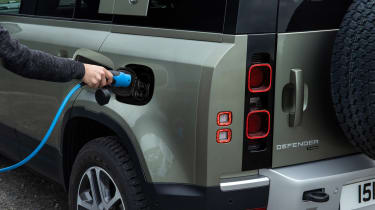Land Rover Defender P400e plug-in hybrid review
The electrified version of the beloved off-roader is more efficient and less polluting than its petrol and diesel siblings, but costs significantly more than them, too

Pros
- Electric driving range
- Rapid charging standard
- More efficient than petrol or diesel siblings
Cons
- High price
- Only available as five-door
- Rivals better on emissions and economy
| Car type | Electric range | Fuel economy | CO2 emissions |
|---|---|---|---|
| Plug-in hybrid | 27 miles | 85mpg | 74g/km |
The electrification of Land Rover’s vehicle line-up is fully underway, with six battery-powered models coming in the next five years and a hydrogen fuel-cell vehicle also in development. While a fully zero-emissions car from the brand has yet to go on sale, this plug-in hybrid version of the Defender is here to help off-road enthusiasts and family buyers improve their fuel consumption and reduce their overall emissions.
Land Rover has launched plug-in hybrid variants of the Range Rover, Range Rover Sport, Velar, Evoque and Discovery Sport, so the electrified variant of the Defender came as little surprise. It uses a 2.0-litre, four-cylinder petrol engine coupled with an electric motor powered by a 19.2kWh battery pack. You can find the same powertrain in the F-Pace P400e SUV from sister company Jaguar.
According to Land Rover, the Defender’s hybrid setup allows for up to 27 miles of pure-electric driving and a top speed of up to 87mph in EV mode. The plug-in Defender will return between 72 and 85mpg fuel economy depending on spec and trim level, which isn’t quite as impressive as the 130mpg yielded by the Jaguar counterpart. The Defender’s claimed electric range and fuel-economy figures also rank poorly compared with other electrified SUV rivals from BMW, Mercedes, Audi and Volvo.
The BMW X3 xDrive30e, Mercedes GLC 300 e and Jaguar F-Pace P400e also produce slightly less CO2, with the plug-in Defender emitting between 74 and 88g/km, which again depends on spec. However, those figures are low enough for the electrified Defender to qualify for a 20% Benefit-in-Kind (BiK) company-car tax rate, starting at £2,079.
But the Defender P400e isn’t just for company-car drivers: Land Rover thinks it'll be popular with private buyers, too. Thanks to the hybrid unit, the electrified Defender offers reduced running costs and strong performance, second only to the top-of-the-range Defender V8. Combined, the plug-in Defender produces 398bhp and a whopping 640Nm of torque, which allows the 2.6-tonne car to accelerate from 0-62mph in just 5.6 seconds.
This Defender has already proved itself to be a well-rounded vehicle, with the road manners of a modern SUV.
The addition of the hybrid unit hasn’t affected the ride quality: the Defender is still surprisingly sharp to turn in, while the suspension also remains slightly firmer than the Discovery's.
There aren’t many noticeable differences between this plug-in Defender and the combustion-engined version, aside from the addition of a charging port on the left rear wheelarch and pure-electric driving ability. You still get the full suite of Terrain Response off-road functions, as well as some electric off-road functions, including a low-range setting for the electric motor. Inside, you get a 12.3-inch driver's display and a 10-inch infotainment touchscreen with Apple CarPlay and Android Auto connectivity.
However, it's worth noting that the Defender P400e is only available in five-door, longer-wheelbase 110 guise and in X-Dynamic and XS Edition trim levels. The plug-in Defender gets an impressive 853 litres of boot space with the rear seats in place, although the hybrid system does eat into that space slightly.
On start-up, the Defender defaults to Hybrid mode, which allows the car to switch between the engine and electric motor depending on what it calculates to be the most efficient. Thankfully, the way it shuffles between the two is almost undetectable, and when running on electric power only, the Defender is extremely refined and quiet. But when the four-cylinder kicks in, it’s noticeably less smooth than the six-cylinder petrols and diesels found elsewhere in the range.
Save mode ensures that the car’s battery retains a certain amount of energy, and will see you rely more on the petrol engine. Of course, in EV mode you can enjoy zero-emissions driving even on the motorway, although given the boxy design of the new Defender, the wind noise when travelling at higher speeds is noticeable.
In terms of running costs, when we tested the plug-in Defender across a mix of roads, we saw up to 40mpg from the display – less than half of the official figure. However, even the lower figure we saw is more economical than the rest of the Defender line-up, so as long as you keep it charged, the PHEV could be an affordable-to-run alternative to its petrol and diesel siblings.
Charging the Defender P400e is simple, too. Recharging the battery to 80% will take two hours from a 7kW home wallbox and the car's 50kW rapid-charging capability (unusual for a plug-in hybrid) means that if you find a fast enough public charging point, you can replenish to 80% in just 30 minutes.
Ultimately, the plug-in hybrid version of the Defender is a brilliant, more efficient version of the beloved off-roader. However, you need to stay on top of charging if you’re looking to match the official economy number, and you need to shell out a fair bit in the first place, too, with prices starting from over £65,000 – £15,000 more than the plug-in variants of the BMW X3, Audi Q5, Volvo XC60 and Mercedes GLC.


